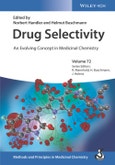The book "Drug Selectivity - An Evolving Concept in Medicinal Chemistry" provides a current overview and comprehensive compilation for medicinal chemists that discusses the effects of aiming for multiple targets on the entire drug development process.
The result is a broad survey of current and future strategies for drug selectivity in medicinal chemistry with theoretical but also practical aspects. Different strategies are presented and evaluated, such as various design approaches, merged multiple ligands, discovery technologies and a broad range of successful examples of unselective drugs taken from all major disease areas. With its wide-ranging view of an emerging new paradigm in drug development, this handbook is of prime importance for every medicinal and pharmaceutical chemist.
The result is a broad survey of current and future strategies for drug selectivity in medicinal chemistry with theoretical but also practical aspects. Different strategies are presented and evaluated, such as various design approaches, merged multiple ligands, discovery technologies and a broad range of successful examples of unselective drugs taken from all major disease areas. With its wide-ranging view of an emerging new paradigm in drug development, this handbook is of prime importance for every medicinal and pharmaceutical chemist.
Table of Contents
PART I. INTRODUCTIONPolypharmacology in Drug Discovery
PART II. SELECTIVITY OF MARKTETED DRUGS
Kinase Inhibitors
New Indications for Marketed Drugs
Discovery Technologies of New Indications
PART III. FIXED-DOSE COMBINATIONS
The Growing Market of Fixed-Dose Combinations
PART IV. UNSELECTIVE DRUGS IN DRUG DISCOVERY
The Growing Importance of Individualising Drugs
Drug Discovery Strategies for the Generation of Multi-Target Ligands against Neglected Tropical Diseases
Designing-In Approach
The Linker Approach (Drug-Conjugates)
Merged Multiple Ligands
Pharmacophore Generation of Multiple Ligands
Cellular Assays
PART V. THERAPEUTIC AREAS FOR DESIGNED MULTIPLE LIGANDS
5HT Transporter-Based Multiple Ligands for Depression
Multiple Ligands Targeting the Angiotensin System for Hypertension
PPAR-Based Multiple Ligands for Metabolic Disease
Antibiotics
Multiple Ligands in Cancer Therapy
Multiple Ligands in Neurodegenerative Diseases








